-
 Figure 2: Differences between the standard ISO method and the two Bluephage Easy Kits.
Figure 2: Differences between the standard ISO method and the two Bluephage Easy Kits. -
 Figure 1: ISO Easy Kit for somatic coliphages according to ISO 10705-2 1 ml sample.
Figure 1: ISO Easy Kit for somatic coliphages according to ISO 10705-2 1 ml sample.
Laboratory Products
New Kit Quantifies Somatic Coliphages in Water According to ISO 10705-2
Jul 19 2022
Viral indicators for efficient detection of faecal and viral contamination of water
Multiple studies conducted by the scientific community affirm that the main source of waterborne pathogens is faecal contamination. Since the 19th century, faecal bacterial indicators have been used to detect the presence of faecal contamination in water and to infer the possible presence of waterborne pathogens. However, many outbreaks caused by viral pathogens transmitted in bacteriologically safe waters showed the need for improved water quality monitoring with faecal viral indicators. The answer to this question is coliphages, viruses that infect enterobacteria, mainly Escherichia coli but not exclusively.
According to the WHO Guide to WASH and Health, there were 829,000 deaths from diarrheal diseases due to poor hygiene in 2016 alone, and approximately 2.3 billion people lacked hand-washing facilities with soap and water in 2020.
Why coliphages?
National and international health agencies have consolidated coliphages as the most suitable viral indicators for the microbiological control of water and the processes of potabilisation, treatment, and reuse of water, sludge, and biosolids, due to their similarities with enteric viruses in terms of their resistance to water treatments and their fate and persistence in the environment. For this reason, during the last 20 years, coliphages, mainly somatic coliphages, have been successively incorporated into numerous regulations and guidelines worldwide, including WHO guidelines for drinking water quality management [1].
Bluephage promotes the use of somatic and F-specific coliphages (bacteriophages that infect coliform bacteria such as E. coli) as viral indicators because when coliphages are present, other viruses may be present. Therefore, control by this viral indicator may prevent some diseases related to human viruses.
Coliphages in routine microbiology laboratory monitoring
Incorporating somatic coliphages in the regulations obliges routine microbiology laboratories to apply their analysis. The standardised method for analysing somatic coliphages was described in 2000 (ISO, 2000) and consists of the double agar layer technique. This technique is based on the observation of plaque-forming units created by somatic coliphages infecting the bacterial host strain culture (E. coli) that grows as a bacterial lawn. This method allows the analysis of somatic coliphages up to 5 ml of sample but can also be applied after a concentration of higher volumes of water [3].
New method for rapid coliphage detection, according to the ISO 10705-2 standard method
The ISO method is not complicated to perform but involves many steps and a few weeks to prepare and calibrate the working bacterial culture and positive control. Bluephage, a biotechnology company founded at the University of Barcelona, specialises in the analysis of coliphages as viral indicators in water, food, and biosolids. Its first product line (Easy Kits) reduces the time and processes to perform the standard methods.
The Bluephage Easy Kit BP1601 provides all components, reagents and biological materials calibrated to simplify the analysis of somatic coliphages according to the ISO method, allowing laboratories with basic microbiological equipment to obtain reliable results. (Figure 1). However, the main advantage of its use is in time (Figure 2), as it saves all the period needed to prepare working cultures. The E. coli lyophiles are ready to use after a 120-150 min incubation and the Φx174 coliphage for positive control is validated by Bluephage to comply with the control chart quality requirements.
This kit allows quantification of somatic coliphages in all types of water: raw and treated wastewater, surface water, recreational water, shellfish extracts, sediments and sludge extract, after dilution when necessary. In addition, it could be applied to drinking water after a higher volume concentration.
With this Easy Kit, Bluephage works to prevent the environmental health threat posed by contaminated water by providing water quality testing laboratories with fast, practical and effective solutions for the early detection of viral contamination of water through coliphages.
- 1. Ballesté, E., Blanch, A.R., Muniesa, M., García-Aljaro, C., Rodríguez-Rubio, L., Martín-Díaz, J., Pascual-Benito, M., Jofre, J., 2022. Bacteriophages in sewage: abundance, roles, and applications. FEMS Microbes 3, 1–12. https://doi.org/10.1093/femsmc/xtac009
- 2. ISO, 2000. International Standard ISO 10705-2:2000. Water Quality - Detection and Enumeration of Bacteriophages. Part 2: Enumeration of somatic coliphages.
- 3. ISO, 2003. International Standard ISO 10705-3:2003 Water Quality- Validation of methods for concentration of bacteriophages from water.
Digital Edition
ILM 49.5 July
July 2024
Chromatography Articles - Understanding PFAS: Analysis and Implications Mass Spectrometry & Spectroscopy Articles - MS detection of Alzheimer’s blood-based biomarkers LIMS - Essent...
View all digital editions
Events
Jul 28 2024 San Diego, CA USA
Jul 30 2024 Jakarta, Indonesia
Jul 31 2024 Chengdu, China
ACS National Meeting - Fall 2024
Aug 18 2024 Denver, CO, USA
Aug 25 2024 Copenhagen, Denmark
-(1)-(1).jpg)


24_06.jpg)













